I-MRSEC’s Principiae Workshop Targets Improving Researchers’ Presentation Skills
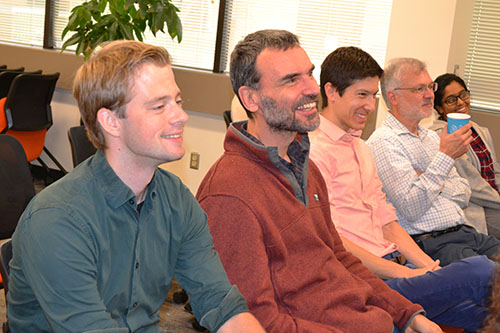
I-MRSEC researchers appreciate Jean-luc Doumont's presentation style.
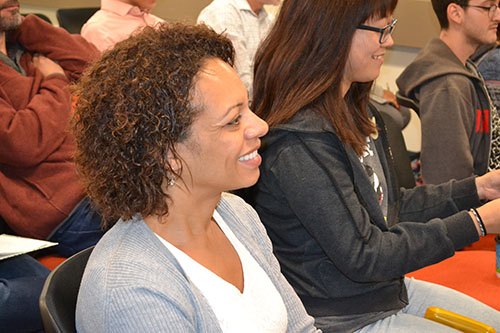
I-MRSEC PI Nadya Mason enjoying the workshop.
October 29, 2019
Why attend a workshop about giving oral presentations? One participant who’d performed numerous calculations for his research, hoped to figure out which to include in his presentations. Another hoped to take her presentations to the next level—to go from just good to great. A third participant admitted that while she loved giving presentations, her body didn’t; she would shake, sweat, and have trouble breathing. These were some of the reasons the 20 or so participants gave for attending the “Making the Most of Your Presentation” workshop presented by Principiae's Jean-luc Doumont. The October 10th workshop, hosted by the Illinois Materials Research Science and Engineering Center (I-MRSEC) focused on training researchers to better communicate their science.
Doumont began the workshop with an icebreaker, during which workshop participants shared their name, the thing they found most challenging about giving oral presentations (such as those mentioned above), plus their favorite color. Following the exercise, Doumont then checked everyone’s listening skills to see if they remembered which color had been mentioned most. They did; it was blue.
Doumont’s presentation philosophy flies in the face of accepted conference presentation protocol, which follows: first, you must stand behind a lectern and present your slides, using a laser pointer. Then, to begin your presentation, you first state your name; give the title of your presentation; state your problem; then outline your research. Finally, after going into a protracted description of the problems you encountered and how you overcame them, you give your final results, hoping the folks in the audience are still awake enough to hear them (or are still even in the room).
Doumont’s idea of a perfect presentation is a bit more radical. For one, he says don't stand behind the lectern. “Body language is a big part of credibility…How can I project confidence with my body if you don't see my body?” In light of that, he also recommends rearranging things in the venue if necessary or asking that changes be made.
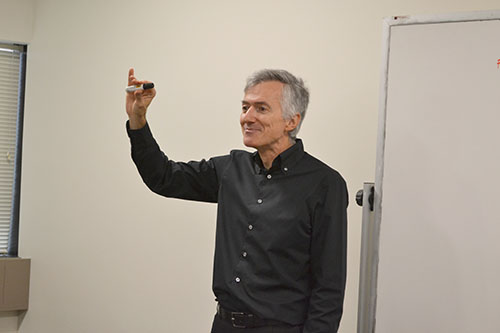
Principiae presenter Jean-luc Doumont exhibit’s one of his favorite dry-erase markers that he brought with him.
“Do what you have to do!” he encouraged participants, explaining that, as a speaker, they need to do whatever it takes so they feel comfortable. He further defended his point by going into an entertaining diatribe about dry-erase markers that, based on the laughter, most folks in the room could identify with.
“See these whiteboard markers? Mine! Why am I bringing my own markers? I mean, the least your organization can do when you invite me to give a workshop is to put markers in the room! Why am I bringing my own?" He then goes on a rant about markers most organizations supply. “They’re always dry...Almost always dry. And they give you seven markers: red, red, red, red, green, green, green. And you wanted the black one, but it’s not in there.” He adds that some markers make a loud sound when you close them, or are not the right writing thickness or slant.
Especially targeting the people who mentioned stress and stage fright, he continues: “These markers are my markers. The ones I want. Always the same. I know how they feel in my hands. It reassures me to have my own. Extra work? Yes. Extra satisfaction when it works as well.”

Fourth year Material Science PhD student Manohar Karigerasi appreciates Doumont's humor.
During one segment, Doumont suggested his structure for a presentation. One of his intriguing suggestions was, don’t start your presentation by stating your name and the title of your presentation. (Besides being mundane, it’s redundant. It’s in the program; the person who introduced you already mentioned it; plus, it’s right there on the first slide of your PowerPoint!). Instead, start with something that will capture the audience’s attention—humor, a story, a demonstration with an object, a question, a quote, even a shocking statement.
Manohar Karigerasi, a fourth-year Material Science PhD student, appreciated the session about the structure of a presentation, especially the attention grabber. “What were some of the examples for grabbing the attention of the audience, especially at the beginning? Whether you can have a question, or a figure, or a statement, maybe a controversial statement—something that can help grab the attention of the audience.”
Karigerasi also shares why he attended the workshop and what he hoped to glean from it.
“I wanted to improve my presentation skills, especially since I had some issues with regards to making a coherent presentation which is suitable for audiences.” He hoped to learn “how to gauge the audience in a better way and how to design the structure of my presentation. So I came here to learn some of these things.”
Regarding Karigerasi’s desire to learn how to gauge the audience better, Doumont spent a lot of time discussing the audience and their point of view. In fact, one of his main emphases was that a presenter should be audience-centric for much of his talk.
“You can pretty much assume when you get on stage and you are going to open your mouth for the first time, the only question your audience has is, “Is it worth staying or should I get out of this room? Why am I still here?’ Right? They want the benefit for them directly.”
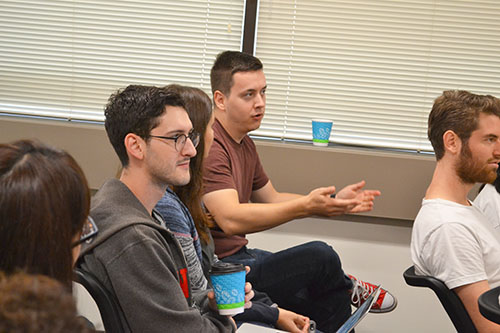
A participant shares during the workshop.
So Doumont’s advice to the workshop participants was this: “How about we make them care, which is part of, of course, making them pay attention.” Another pithy comment regarding the audience was: “Adapt to your audience. Don't expect them to adapt to you,” still another: “Stop thinking like a speaker; start thinking like an audience.”
Part of Doumont’s emphasis on the audience was that both the beginning of the presentation, as well as the end, should be focused on the audience and why your research should matter to them. Elif Ertekin, a Mechanical Science and Engineering Professor and I-MRSEC researcher, especially appreciated the emphasis on the audience. “So this idea about focusing on the audience, bringing them in and then in the end, pulling it back together, but focusing back on the audience, I think, is really nice.”
Regarding interacting with the audience, one of Doumont’s suggestions that he mentioned several times was this: never practice in front of a mirror. Why? Because you’re focusing on yourself. "it's not getting the best out of you," he explains. "You're talking to yourself, right?" In fact, he shared a fun example of something he does to get into the habit of focusing on the audience.
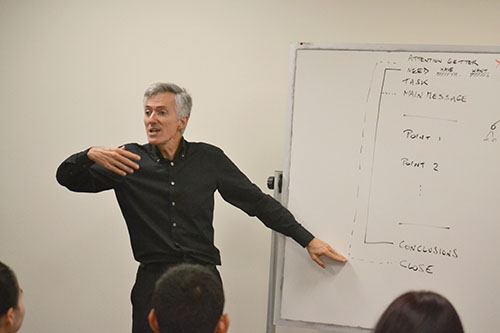
Jean-luc Doumont presents his structure for a presentation.
"So just don't tell anyone. That's got to be our little secret, but I practice in front of teddy bears." He arranges them around the room, one in the center, one on the left and on the right, then practices his presentations in front of them, shifting his focus back and forth to all three. "Now, there's something about Teddy bears," he continues, "They've got this face that says to you, 'Look, I don't have much background knowledge on this topic.' That's what the Teddy bear is begging me. It gets the best out of me, right?"
Another of his unique suggestions regarding a presentation's organization involved where to put the findings. Following the attention getter, Doumont suggested that presenters address the need, the task, and then surprisingly, the main message or findings. Instead of burying your message at the end, he advocates stating it up front before the main points.
This change in structure was an idea that workshop participants were intrigued by. For example, Elif Ertekin says, “I really also like this idea of laying out your presentation almost a little bit like a lawyer, making your case up front, stating your conclusion, and then making your points as evidence for your argument. I think that's a really nice way to think about it. So I'll try this yet.”
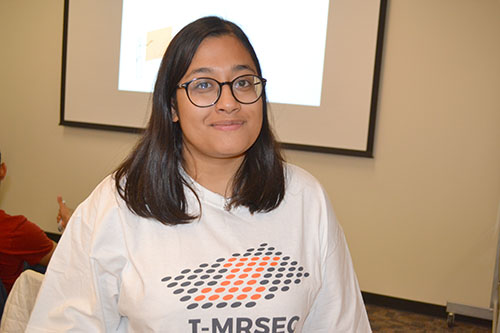
Preethah Sarkar, a third year PhD student in Professor Nadya Mason’s group.
She adds that this principle is something that’s practiced in research writing as well. “A lot of this applies to writing a paper—how to structure a paper. We do the same thing, I think, in many ways. Best practices are, don't build it up like a Hollywood movie with a big revealing moment somewhere in the middle. State what you learned; explain it to your audience. Don't take them through your personal experience of learning. It's very interesting to see the parallels.”
Another workshop participant who appreciated the findings-at-the-beginning idea was Preethah Sarkar, a third year PhD student in Professor Nadya Mason’s group.
“It's pretty different from what we usually do in a presentation in terms of background and then previous work. So that seemed very radical, and something new, and a lot of it did make sense. So I've been thinking in my mind, how can I apply that? That might be useful. It's more like when you have a research article, you have a small abstract at the beginning, which discusses everything, including the results, and most people do read that, and then the rest of the paper. So kind of bringing that into oral presentation. It's very useful, but very different.”
Sarkar, who studies how the electronic properties of materials like graphene are affected by strain or any sort of deformation, reports that she came to the workshop in order to improve her style of presentation. “There are some specific things I think I need more help with, like the piece of my speech or what exactly to use in my slides to engage the audience. Things like that.”
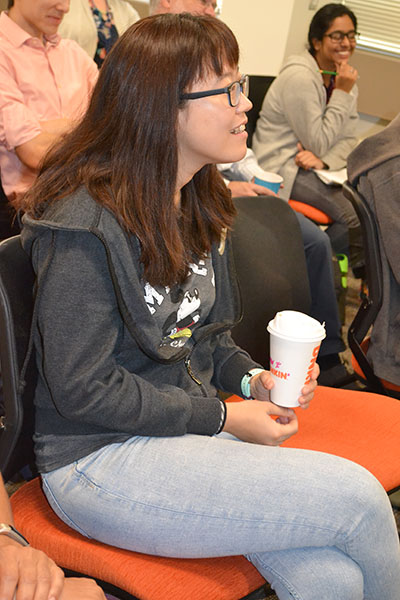
Juyoung Leem enjoying the workshop.
Juyoung Leem, a Mechanical Science and Engineering PhD student who is a part of I-MRSEC, shares why she participated in the workshop.
“I have a high desire to do a better job, because I did not do a really good job in past conferences. And also, my final exam for my PhD is coming up. So I wanted to learn how to convey my thing better to the audiences.”
Based on participants' comments, those who attended the workshop appreciated the novel ideas, and planned to implement some of them. For instance, I-MRSEC faculty member Elif Ertekin, doubtless an old pro at giving presentations, shares why she participated in the workshop and also acknowledges that she learned some new things.
“It's always really helpful for me to see how people who have really put time into thinking about how to give an effective presentation think about it, how they present their ideas, what their framework is. I think it helps me with my presentations, but it also helps me think about how to communicate to my students how to give effective presentations.”
In fact, Ertekin says there were a couple of nice ideas she picked up at the workshop that she’s going to try to implement. Something else she appreciated was receiving confirmation regarding things she’s figured out and been implementing over the years.
“ideas that I realized that after years of giving presentations, you kind of intuitively pick up on your own. But when you hear it formally presented or communicated, you realize that ‘Ah, this needs to also be communicated to younger students who are learning to give presentations.’”
Jean-luc Doumont has been training people to do presentations for 26 years. And when he speaks to scientists, he knows where they’re coming from, because his undergraduate degree was in engineering and his PhD in Applied Physics. So how did he get from engineering to training people how to present? He describes his journey.
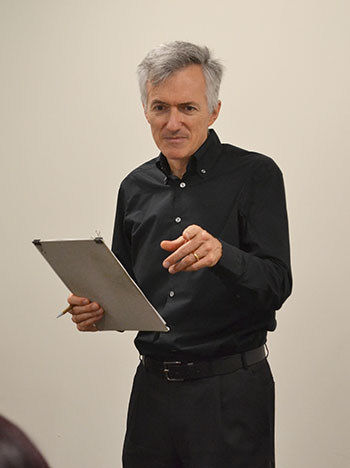
Jean-Luc Doumont of Principiae interacts with the audience.
“I had to give talks,” he explains, “and I was told that I was good, but I had no idea what was good about it. So I was extremely insecure. I would follow my guts, keep my fingers crossed, but never know if it was going to work or not. I had no methods.”
Then, while working on his PhD at Stanford, he took an engineering class called public speaking. “I jumped at it, took it, loved it, ended up teaching it as a teaching assistant,” he explains. While it was quite limited compared to what he teaches now, he says, “It was a start.”
After finishing his PhD, he returned to Belgium to complete his one-year compulsory military service. He told himself, “Military service. I'm not going to get paid for a whole year. I mean, they can take care of my every need, but I don't want to go and sleep in the barracks with crazy guys. I want to keep my apartment. I need extra money.”
While doing a postdoc here in the states, he had been doing a side gig, teaching folks how to give presentations on nights, weekends, and free days. So he continued to do that while in the military. “Every opportunity I had, I would do work for clients, which is a comfortable position—to try a dream you have while not having the pressure of having to earn enough.”
At the end of his military service, he thought, “‘Okay, now I need to make a choice. What do I want to do?’ I thought, ‘I love doing this. It addresses a need. People are ready to pay for this. I have proof now. Let's launch a company and do it full time.’ So here we are more than 25 years later, and I'm still doing it more than full time, running around the planet and doing it everywhere.”
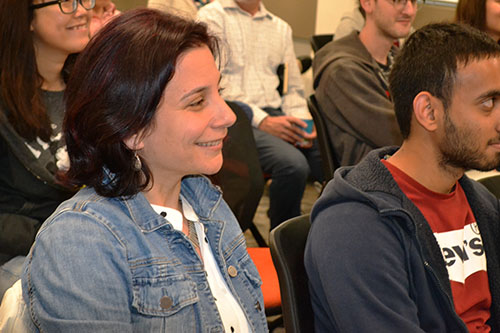
Elif Ertekin enjoying Doumont's presentation.
Why is there a need for training in scientific communication? For one, Doumont says not just scientists, but people in general don’t really receive training in how to do oral communication effectively. “We don't learn it, right? So people learn it by imitation. But that does not make the system converge to best practices. We can see people doing it wrong, and do the same. So that's for everyone. We don't learn it. It needs to be learned.”
One thing that’s changed drastically since the beginning of his career until now, is that universities have finally figured this out. When he started his career, it was almost exclusively companies. Universities wouldn’t pay for training of this sort. “They would assume that you learn it by magic,” he says. Nowadays, he says he can’t keep up with the demands from universities. “They’ve realized it's their job to make the PhD students employable, and so they need to give those people the skills. It's not, ‘You will learn it magically on the job.’ Now it's ‘We'll help you with it!’”
He also says that good public speaking means visibility careerwise. He indicates that if someone wants to have a brilliant career, “They need to be able to communicate. In fact, the higher you go in a hierarchy, the more you communicate, which means they will only promote bosses that are able to communicate.”
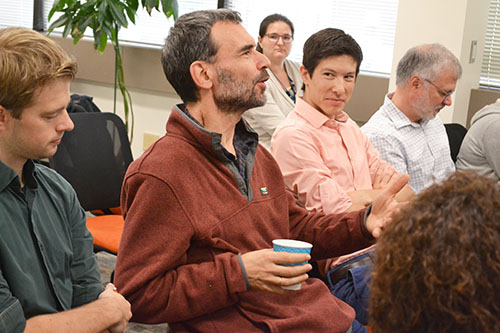
MRL researcher Roland Winkler interacts with Doumont during the workshop.
As far as why training to communicate is so important for researchers, he explains, “If you think of it, the outputs of the work of most researchers is papers and presentations. They don't build things that they sell. They just do papers and presentations. So that's the essence of their work. They have to learn how to do that well.”
Here’s another reason he says researchers need to be able to communicate. “A great deal of research is done with public money. The public is asking more than ever before to know what's being done with their money,” he explains. So the need to communicate, not just to fellow scientists, but to lay audiences is much higher than before.
Lastly, regarding the Geniuses-Can’t-Socialize-or-Communicate stereotype, Doumont has a theory: “Brilliant people tend to think that the brilliant character of their work is enough, and they can get away with bad communication.” In fact, of the lectures or full courses he’s experienced with eight Nobel laureates, with one exception, “They were the worst,” he says, “because they think they don't have to pay to make any efforts. Their science speaks for itself, they think, and disaster!”
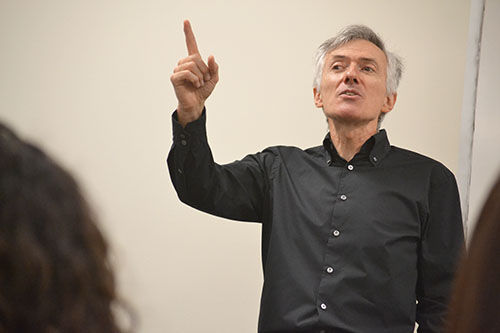
Jean-luc Doumont emphasizes a point during the workshop.
The one exception was a physicist at CERN. "I still remember things he said to me in 1985 in the lecture. You know, that's an effective speaker." In fact, Doumont still remembers the visuals he used. He didn't have slides but used an overhead projector. One thing he did clearly impressed Doumont.
The CERN physicist was discussing an alpha emitter (a radioactive emitter with big particles). So he put shampoo in a handkerchief, blew through it, producing a big cluster of bubbles, then put that on the overhead projector so the audience could see the bubbles on the screen. Then he took an alpha emitter from a little lead box and approached it. The radiation was strong enough to pop the bubbles.
“You could see on the screen the bubbles popping because of the alpha emission from the source,” Doumont explains. “I still remember that, because that was really understanding the essence of things and not getting lost in slides.”
Story and photographs by Elizabeth Innes, Communications Specialist, I-STEM Education Initiative.
For more I-STEM articles about I-MRSEC, see:
- Via I-MRSEC’s Magnetic Fields Web Series, Youth Discover Magnetism, Diversity in Science
- I-MRSEC REU Teaches Carmen Paquette a Lot About Magnetism, Research, and Herself
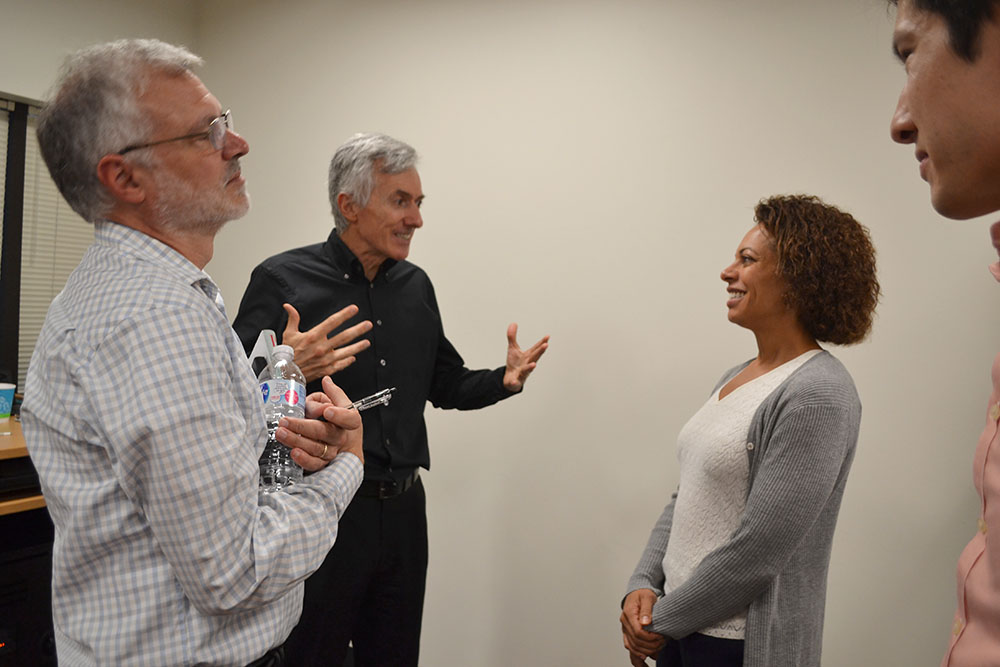
David Cahill, Jean-Iuc Doumont, Nadya Mason, and Daniel Shoemaker interact following the workshop.













.jpg)
















